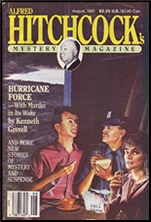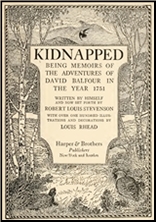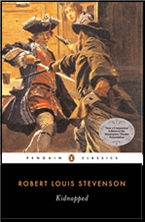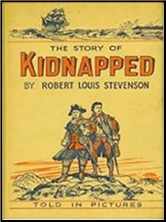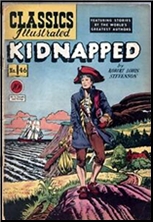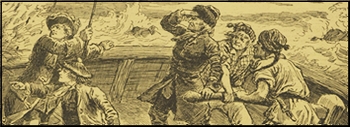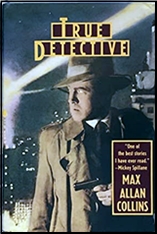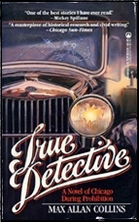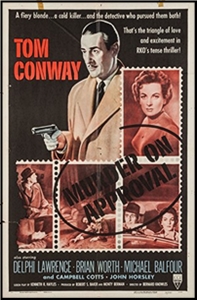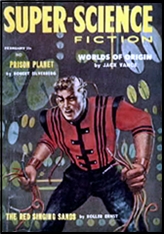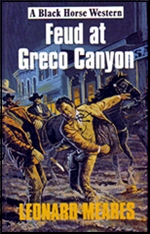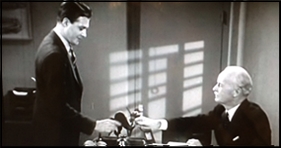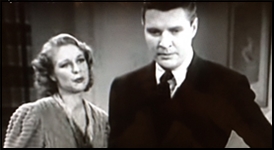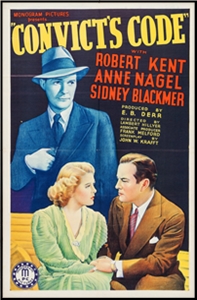REVIEWED BY DAVID FRIEND:
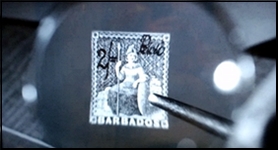
BARBADOS QUEST. RKO Pictures, UK/US, 1955. Released in the US as Murder on Approval. Tom Conway, Delphi Lawrence, Brian Worth, Michael Balfour, Campbell Cotts, John Horsley, Ronan O’Casey, Launce Maraschal. Writer: Kenneth R. Hayles. Director: Bernard Knowles. Currently available on YouTube.
J. D. Everleigh (Launce Maraschal) a proud and wealthy American philatelist (stamp collector to you and me), purchases a rare stamp named the Barbados Overprint for $10,000 from Geoffrey Blake (Brian Worth), who claims to represent the respected expert Robert Coburn (Campbell Cotts). The stamp is the only one on the market and belonged to the late Lord Hawksley.
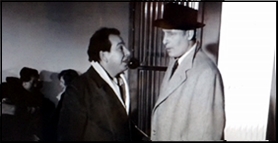
A curious condition of the sale dictates that no buyer can reveal the purchase for six months. However, upon returning to America, Everleigh discovers that a friend seems also to have purchased the stamp and suspects that his own is a fake. He enlists the help of English, New York-based private detective Tom Martin (Tom Conway).
Tom flies to England and reteams with old army friend and former petty thief Barney Wilson (Michael Balfour). They learn that Robert Coburn knows nothing about the sale or anyone named Blake. The real stamp apparently remains in the possession of Hawksley’s widow (Grace Arnold). Tom’s roving eye settles on her secretary, Jean Larson (Delphi Lawrence), who reveals that Hawksley’s nephew is Geoffrey Blake. It seems Blake arranged the sale himself without permission, sold the real one to Everleigh and left the fake with his aunt, who knows little of stamps and would not know the difference.
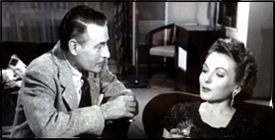
This seems to be true when Everleigh’s stamp is authenticated. However, it does not explain how such a rare stamp has suddenly become so common. Tom discovers that an engraver at a printing firm named Stefan Gordoni (Ronan O’Casey) is part of what appears to be a counterfeiting ring but, before the police can be summoned, Gordoni is killed by an unseen assailant and his body later disappears. Detective Inspector Taylor (John Horsley) wades in after a burglary at Coburn’s office in which nothing is apparently stolen and distrusts Tom enough to threaten him with deportation if he doesn’t return to America at once. Tom is threatened by the bad guys too and, when he doesn’t obey, Jean is kidnapped.
SPOILERS BEGIN —
It turns out that Blake and Coburn were running a racket in which they could sell duplicates of rare stamps multiple times, demanding silence from their buyers while they went about enlisting more. However, when Gordini finds out why he was hired to make the counterfeits and the amount of money that was earned because of them, he robs Coburn’s office, steals the engraving plates from which he had duplicated the stamp and blackmails Coburn for $2,000.

He is promptly killed by Blake, who then frames Coburn for the murder and kills him too, making it look like suicide. Gordoni, however, had suspected such countermeasures and arranged for the engraving plates to be sent to Coburn in return for the money. Tom intercepts the parcel and Jean is kidnapped to make him hand it over. However, it turns out that Everleigh’s stamp was indeed a fake. Jean is Blake’s lover and switched it for the real one in an effort to get Tom off the case. Before Blake can retrieve the incriminating plates, Tom captures him and the police arrive.
SPOILERS END —
This B-film from producers Robert S. Baker and Monty Berman is very much in the style of their later television success The Saint. Indeed, Tom Conway had played The Saint on American radio and was best known for The Falcon, an identical character, in a series of 1940s B-films he had inherited from his brother George Sanders, who had also donned the halo. Like those films, this British effort was distributed by RKO and sticks so closely to the formula that it is almost indistinguishable from a Falcon film, but with names changed and the setting switched to England.

Conway is as good as ever, with his Errol Flynn-like good looks and suave, twinkly-eyed demeanour – though, at 51, was beginning to show his age. At this point in his career, the actor was suffering from alcoholism and looking to Britain for leading roles in B pictures. He had recently played Norman Conquest (of the long-running, but now forgotten, series of suspense novels) in Park Plaza 605 and a character curiously named Tom Conway in Blood Orange (both 1953).
Here, he is Tom ‘Duke’ Martin. As with the Falcon series, he has a stout, former crook for a comical sidekick, now played by reliable B-film regular Michael Balfour. Elsewhere, Brian Worth as Blake is conceited, vaguely sinister and reminiscent of a young Dennis Price, while John Horsley is excellent in another of his many detective portrayals.

However, while the counterfeit racket is a neat one and a car chase perks things up in the middle, the plot is somewhat convoluted and the viewer must keep track of which is the real stamp. The villain is more or less known from the outset and the interest comes from how Tom makes sense of it all, so there is little consistent suspense.
I saw it twice before I understood everything, so can only imagine how cinema-goers felt on seeing it only once. The ‘Jean’ character, moreover, starts out well enough but quickly takes on a stoned look (even during the car chase!) and there’s an appearance from an oriental dancer which seems superfluous.
These quibbles aside, this is a functional B-film and a must-see for fans of The Falcon. A sequel, Breakaway, was released the next year and confusingly featured Horsley and Worth in different roles while Conway and Balfour returned. Both films were a success, mostly due to the Dean Martin and Jerry Lewis comedies they were paired with, and a television series was apparently even mooted, though did not materialise.
Rating: ***
